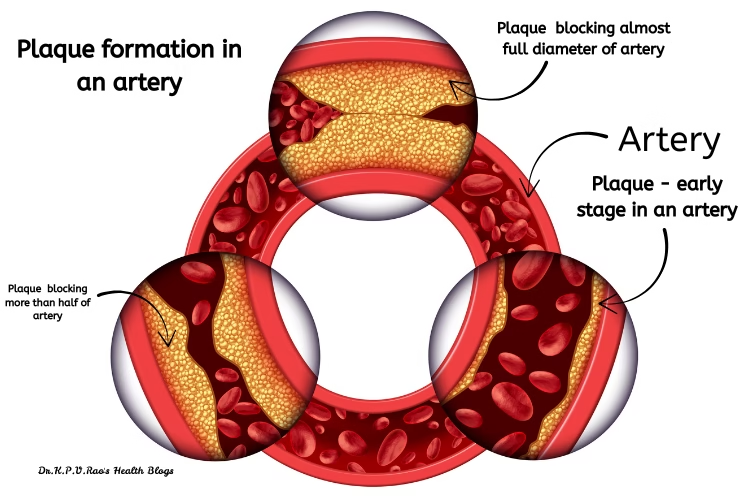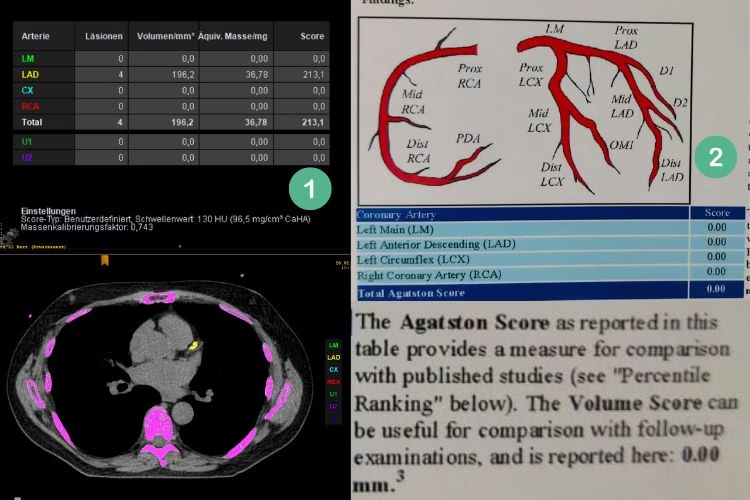After studying about CT angiogram , also referred to as computed tomography angiography cta, finished by a process referred to as CT-angiography, we transfer forward to be taught extra about it, and its makes use of.
On this article we’ll learn the way doing a CT-angiography finished in a suspected case of coronary coronary heart illness might help the affected person to forestall future occasions like coronary heart assault. A multislice ct angiography might help us study
So, let’s start by-
Levels in Assessing Plaque Well being within the Coronary heart
To start with, let’s perceive what a plaque means. Plaque is a deposit of ldl cholesterol within the wall of the coronary or coronary heart artery. Additional time, this plaque grows after which blocks the lumen of the artery, thereby chopping off the blood provide to the center muscle inflicting harm or dying of the muscle in that space.
The image beneath reveals how a small plaque initially progresses to dam an artery absolutely:

The analysis of plaque well being inside the coronary arteries is essential for understanding cardiovascular dangers and guiding remedy methods.
This evaluation is usually carried out by way of a number of distinct phases, beginning with the classification of plaques, which might fluctuate in morphology and composition.
Classification of plaques in CT-Angiography of Coronary heart
The 2 main kinds of plaques recognized in CT-angiography of the center are secure (calcified) and unstable (non-calcified or blended).
Steady plaques are characterised by a fibrous cap that minimizes the danger of rupture, whereas unstable plaques are extra liable to rupture, which might result in acute coronary occasions.
As soon as the plaque is classed, the subsequent stage includes visualization methods employed by CT-angiography. Superior imaging permits for detailed evaluation of plaque traits, akin to thickness, density, and the presence of a lipid pool. These particulars are important as a result of they supply insights into the steadiness of the plaque, informing medical choices in regards to the necessity for intervention or nearer monitoring. Excessive-resolution CT scans can reveal refined modifications in plaque construction, highlighting areas that will warrant additional investigation or therapeutic intervention.
Plaque Calcium Rating Measurements utilizing CT-angiography
Furthermore, quantitative measurements such because the Agatston rating can help cardiologists in assessing the general burden of coronary artery illness.
This scoring methodology evaluates calcium ranges inside plaques, providing a dependable estimate of plaque severity and the potential for hostile occasions. The correlation between plaque well being evaluation through CT-angiography of the center and affected person prognosis is critical because it contributes to danger stratification and individualized remedy planning. Consequently, understanding plaque well being isn’t merely an instructional train however carries substantial implications for affected person outcomes and long-term administration of cardiovascular well being.
Significance of Plaque Calcium Rating in Coronary heart Well being
Plaque calcium rating measurements are an vital development in assessing the cardiovascular well being of sufferers. Derived from CT-angiography of the center, these measurements make the most of superior imaging methods to detect and quantify the quantity of calcified plaque inside the coronary arteries. This data performs a essential function in evaluating an individual’s danger for cardiovascular occasions, akin to coronary heart assaults and strokes, which are sometimes related to atherosclerosis—a situation characterised by the buildup of plaque within the arteries.

2. Picture of CT- angiography of considered one of my sufferers with Agatston Rating
The scoring system for calcium scoring sometimes employs the Agatston methodology, which is extensively accepted in medical observe.
On this methodology, the quantity of calcium current within the coronary arteries is quantified and assigned a rating.
The scoring ranges from zero, which signifies no detectable calcium and a low danger of coronary heart illness, to increased scores that correlate with elevated ranges of calcified plaque and a corresponding rise in cardiac danger. For example, a rating of 1-10 suggests minimal danger, whereas scores above 400 are related to the next probability of serious coronary artery illness.
These calcium scores derived from CT-angiography present useful insights into the general coronary heart well being of sufferers. They might help information remedy choices, permitting healthcare suppliers to develop applicable danger mitigation methods.
Moreover, sufferers with elevated scores could also be suggested to have interaction in life-style modifications, akin to improved food regimen and elevated bodily exercise, or could also be candidates for pharmacotherapy to decrease their cardiovascular danger.
Understanding plaque calcium rating measurements, along side different medical assessments, is crucial for efficient cardiovascular danger administration.
What are the advantages of CT-Angiogram
CT-angiography of the center gives a number of benefits over conventional diagnostic strategies akin to invasive coronary angiography and different imaging modalities. One of many main advantages of this non-invasive imaging method is that it minimizes affected person danger. In contrast to conventional angiography, which requires catheter insertion into the blood vessels, CT-angiography makes use of superior imaging know-how, thereby avoiding problems related to invasive procedures.
One other important benefit of CT-angiography is the velocity at which ends up are obtained. In medical settings, well timed prognosis is essential, particularly for circumstances associated to coronary artery illness. A CT-angiogram can typically be carried out inside a matter of minutes, and the imaging outcomes can be found promptly, permitting physicians to make fast and knowledgeable choices a couple of affected person’s care. This expedited course of is helpful for each healthcare suppliers and sufferers, because it helps within the well timed administration of potential coronary heart points.
Furthermore, CT-angiography of the center offers an in depth, three-dimensional view of the coronary arteries. This stage of element is invaluable for assessing the presence and extent of coronary artery illness, because it permits for an correct analysis of blood circulate and any blockages that will exist inside the arteries. The high-resolution photos obtained can reveal not solely the anatomy of the arteries but additionally the diploma of stenosis, thus serving to in tailoring applicable remedy plans. As well as, CT-angiography might be significantly helpful in sufferers the place conventional strategies is likely to be much less efficient or the place integrating outcomes may improve diagnostic accuracy.
General, the non-invasive nature, speedy consequence turnover, and detailed evaluation offered by CT-angiography of the center make it a most well-liked selection for a lot of clinicians within the analysis of cardiac circumstances and affected person administration.
Potential Dangers and Issues
Whereas CT-angiography of the center is extensively thought to be a useful diagnostic software, it’s important to contemplate potential dangers and vital elements related to the process.
One main concern is radiation publicity. CT scans make the most of ionizing radiation, which might contribute to an elevated danger of most cancers over a lifetime, significantly in sufferers who endure a number of scans.
Regardless of this danger, the advantages of acquiring correct diagnostic data typically outweigh the potential hurt, significantly when carried out judiciously and in accordance with present medical pointers.
One other important consideration includes using distinction brokers throughout a CT-angiogram of the center. Most procedures make use of iodinated distinction supplies, which assist improve the visibility of blood vessels.
Nevertheless, these brokers can provoke allergic reactions in some sufferers. Reactions might vary from gentle signs, akin to hives or itching, to extra extreme responses, together with anaphylaxis. Sufferers with recognized allergy symptoms to iodine or shellfish ought to inform their healthcare supplier, who might take extra precautions or think about various imaging methods if deemed essential.
Moreover, sure affected person populations might face extra challenges when contemplating a CT-angiogram. People with compromised renal perform are at heightened danger of contrast-induced nephropathy, a situation that may result in acute kidney harm.
Sufferers with diabetes or these taking medicines that have an effect on kidney perform ought to be carefully monitored. Moreover, pregnant girls are typically suggested to keep away from pointless radiation publicity except completely required for maternal or fetal well being, necessitating a radical dialogue of dangers versus advantages with a healthcare skilled.
In gentle of those concerns, it’s essential for sufferers to have interaction in an open dialogue with their medical suppliers, guaranteeing that every one potential dangers related to CT-angiography of the center are absolutely understood and managed appropriately.
Future Tendencies in CT-Angiography
The sphere of CT-angiography of the center is repeatedly evolving with developments in know-how, which promise important enhancements in each diagnostic accuracy and affected person outcomes.
One of the crucial noteworthy tendencies is the mixing of synthetic intelligence (AI) in picture evaluation. AI algorithms have demonstrated a outstanding capacity to reinforce picture high quality and help radiologists in deciphering complicated datasets.
By automating sure elements of picture evaluation, these applied sciences can scale back human error, streamline workflows, and speed up the identification of essential cardiovascular circumstances.
Moreover, developments in imaging methods are pushing the boundaries of what CT-angiography can obtain. For instance, the event of dual-energy CT imaging permits for the differentiation of assorted tissue varieties, which might be significantly helpful when evaluating coronary artery illnesses.
This know-how not solely enhances the distinction decision but additionally enhances the flexibility to detect refined modifications in plaques that will in any other case go unnoticed. Such refinements in imaging capabilities allow clinicians to develop extra tailor-made remedy plans for sufferers, in the end bettering preventive care.
Furthermore, the way forward for CT-angiography might contain the incorporation of practical imaging, which assesses the physiological elements of blood circulate and cardiac perform concurrently.
Such complete imaging approaches can present a extra holistic view of a affected person’s cardiovascular well being, permitting for a extra correct prognosis. Integrating these developments into commonplace observe may revolutionize the panorama of cardiac diagnostics.
Conclusion
In conclusion, the long run tendencies in CT-angiography herald thrilling prospects for the realm of cardiovascular imaging.
The mixture of modern imaging methods and AI-driven evaluation holds the potential to considerably enhance diagnostic precision and affected person administration, paving the best way for enhanced medical outcomes within the administration of heart-related illnesses.
Closing phrases
When you have discovered this text helpful, please share it on X-
CT Angiography Prognosis and far more… Share on X
Do be a part of my electronic mail listing to obtain extra articles like this one in your inbox –
Please allow JavaScript in your browser to submit the shape
You too can share this text through social media apps below-
